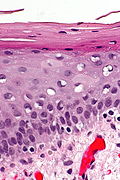Difference between revisions of "Uterine prolapse"
Jump to navigation
Jump to search
| Line 1: | Line 1: | ||
'''Uterine prolapse''' is a frequent benign pathology of the uterus and a common reason for hysterectomy. | '''Uterine prolapse''' is a frequent benign pathology of the [[uterus]] and a common reason for [[hysterectomy]]. | ||
==General== | ==General== | ||
Revision as of 15:08, 16 May 2016
Uterine prolapse is a frequent benign pathology of the uterus and a common reason for hysterectomy.
General
- Clinical diagnosis.
- A common indication for a total hysterectomy.
- Hysterectomy specimen usually comes with some vaginal mucosa.
- Parous women, usually menopausal.[1]
- Possibly obesity - studies vary.[2]
Gross
- Long cervix.
Microscopic
Features:
- Uterus: non-specific.
- Vaginal mucosa: (focal) keratinization due to rubbing - common finding.
Note:
Images
Sign out
UTERUS AND CERVIX, TOTAL HYSTERECTOMY: - UTERINE CERVIX WITH FOCAL KERATINIZATION OTHERWISE WITHIN NORMAL LIMITS. - NONPROLIFERATIVE ENDOMETRIUM.
UTERUS AND CERVIX, TOTAL HYSTERECTOMY: - UTERINE CERVIX WITH KERATINIZATION, OTHERWISE WITHIN NORMAL LIMITS. - CYSTIC NONPROLIFERATIVE ENDOMETRIUM. - UTERINE SMOOTH MUSCLE AND SEROSA WITHIN NORMAL LIMITS. - NEGATIVE FOR MALIGNANCY.
Denudated exocervix
UTERUS AND CERVIX, TOTAL HYSTERECTOMY: - UTERINE CERVIX WITH MILD CHRONIC INFLAMMATION AND EXOCERVICAL DENUDATION, NO EVIDENCE OF DYSPLASIA. - CYSTIC NONPROLIFERATIVE ENDOMETRIUM. - UTERINE CORPUS WITH BENIGN HYALINIZED NODULE. - NEGATIVE FOR MALIGNANCY. COMMENT: Levels were cut on the uterine cervix sections (A1 and A2).
Focal ulceration
- UTERINE CERVIX WITH PARAKERATOSIS, ACANTHOSIS, CHRONIC INFLAMMATION, AND FOCAL ULCERATION ASSOCIATED WITH GRANULATION TISSUE FORMATION. - PARTIALLY CYSTIC NONPROLIFERATIVE ENDOMETRIUM. - UTERINE CORPUS WITH LEIOMYOMA. - NO EVIDENCE OF DYSPLASIA. - NEGATIVE FOR HYPERPLASIA AND NEGATIVE FOR MALIGNANCY.
With endometrial polyp
UTERUS AND CERVIX, TOTAL HYSTERECTOMY: - BENIGN ENDOMETRIAL POLYP WITH NONPROLIFERATIVE ENDOMETRIAL GLANDS. - UTERINE CERVIX WITH MILD CHRONIC INFLAMMATION AND FOCAL EXOCERVICAL DENUDATION, NO EVIDENCE OF DYSPLASIA. - VERY WEAKLY PROLIFERATIVE ENDOMETRIUM, MOSTLY ATROPHIC APPEARING, NEGATIVE FOR ENDOMETRIAL HYPERPLASIA. - UTERINE CORPUS WITHIN NORMAL LIMITS. - NEGATIVE FOR MALIGNANCY.
See also
References
- ↑ Mladenović-Segedi, L.; Segedi, D.. "[Most important etiologic factors in the development of genital prolapse].". Srp Arh Celok Lek 138 (5-6): 315-8. PMID 20607975.
- ↑ Thubert, T.; Deffieux, X.; Letouzey, V.; Hermieu, JF. (Jul 2012). "[Obesity and urogynecology: a systematic review].". Prog Urol 22 (8): 445-53. doi:10.1016/j.purol.2012.03.009. PMID 22732579.
- ↑ Nucci, MR.; Young, RH.; Fletcher, CD. (Feb 2000). "Cellular pseudosarcomatous fibroepithelial stromal polyps of the lower female genital tract: an underrecognized lesion often misdiagnosed as sarcoma.". Am J Surg Pathol 24 (2): 231-40. PMID 10680891.
- ↑ Rodrigues, MI et al. (April-June 2009). [http://www.medigraphic.com/pdfs/patrevlat/rlp-2009/rlp092e.pdf "Atypical stromal cells as a diagnostic pitfall in lesions of the lower female genital tract and uterus: a review and presentation of some unusual cases"]. Patología 47 (2): 103-7. http://www.medigraphic.com/pdfs/patrevlat/rlp-2009/rlp092e.pdf.


